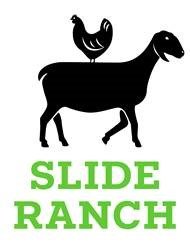Raising Chickens
Here at Slide Ranch, we keep chickens for both egg and meat production, however our primary flock and the ones we interact with the most are our layers. They’re definitely a fan favorite of many of the campers and visitors to Slide Ranch! We have a number of different chicken breeds, some more “practical” layer hens and others more fun and silly. Though we primarily keep our birds here for practical reasons, such as eggs and meat, they also make fantastic backyard pets. Chickens have a ton of personality and provide endless entertainment with their various antics. They also make wonderful walking compost bins! Of course, nothing beats a fresh egg for breakfast from a happy hen.
If you happen to be considering a few chickens to add to your family, they are no more challenging to care for than a dog or a cat. Chicks require very specific temperature control while they are young since they cannot yet regulate their own body temperature well enough to survive on their own. In environments where there is no mother hen to keep them warm, chicken owners will use heat lamps above a brooder area to keep them at a comfortable temperature. Chicks need a heat lamp to keep them warm until they have developed enough feathers to regulate their own temperatures. As babies, you also need to keep a close eye on their health and watch for a number of possible issues. Medicated chick feed helps protect them from things like coccidiosis and boost their immune systems. Adding electrolytes to their water helps with stressful situations and hydration. As they get older, they transition to grower feed and eventually layer feed which contains the calcium they need to begin laying eggs.
They can be somewhat high maintenance while young, so while you can hatch your own or buy freshly hatched chicks to start your flock, sometimes getting older teenage chickens (pullets) or fully grown adult chickens can be a better option for those who don’t have the time to care for chicks or can’t wait for eggs!
Raising chickens is the most intensive part of chicken keeping. Once they are established layers, it’s likely less work than having a dog. Coops need regular cleaning to stay smelling fresh and prevent gross things from incubating. Water is changed and cleaned frequently. Ensure they have access to enough food and provide a big, safe space to roam. Of course, chickens are also great to hang out with! To ensure your chickens are friendly, handle them frequently and spend a lot of time with them the same way you would with your dogs or cats.
When considering which chicken breeds to get, it is important to research what breeds do best in your environment and are best suited for your needs. If you want chickens primarily for eggs or meat, there are a lot of them that are bred specifically to lay more consistently or to grow large enough for a quick harvest. There are dual purpose breeds as well! If you want a chicken that maybe isn’t the best layer or meat bird but is silly looking or has really beautiful feathers then there are plenty of options as well. A few breeds such as Barred Plymouth Rocks, Buff Orpingtons, Wyandottes, Ameraucanas, Rhode Island Reds and Speckled Sussex are very popular “starter” chickens breeds as they are known to be friendly while still being good layers. Things like general care, coop design, how much space you have for them, types of food and bedding and what/how many chickens your county allows are all important to plan and prepare for as well. There are many options - so doing a lot of research is a must!
P.S. Join us at an upcoming workshop, Fall Family Farm Days, and Farm to Belly Supper Series! Our herbal mocktail mixology workshop is coming up soon. We have a few camp spots remaining next week!












